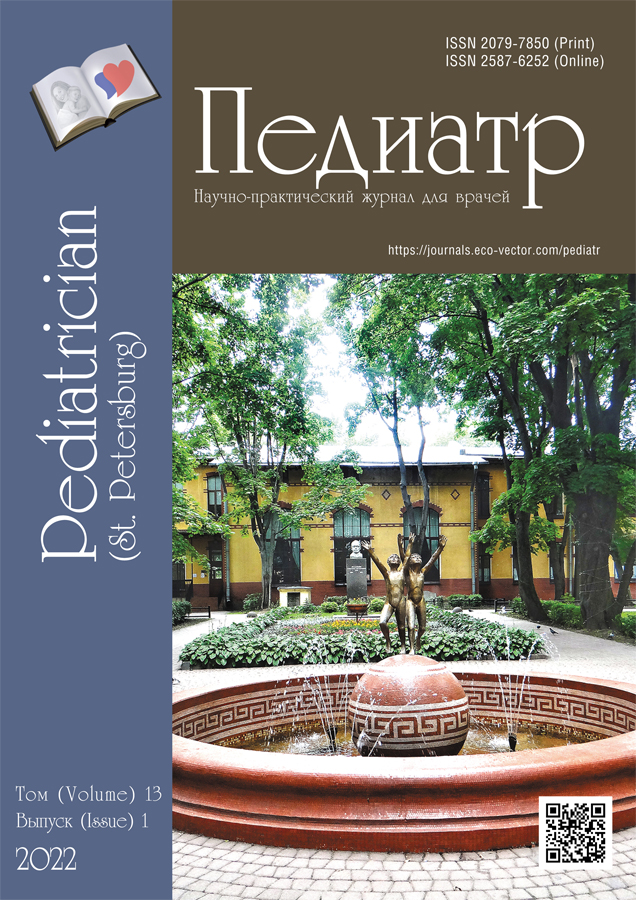Плексиформная нейрофиброма орбиты в сочетании с врожденной глаукомой у ребенка с нейрофиброматозом I типа: случай из практики
- Авторы: Болотникова И.В.1, Иванов В.П.1, Шаповалов А.С.1, Хачатрян В.А.1, Бржеский В.В.2
-
Учреждения:
- Национальный медицинский исследовательский центр имени В.А. Алмазова
- Санкт-Петербургский государственный педиатрический медицинский университет
- Выпуск: Том 13, № 1 (2022)
- Страницы: 61-68
- Раздел: Клинический случай
- URL: https://journals.eco-vector.com/pediatr/article/view/108384
- DOI: https://doi.org/10.17816/PED13161-68
- ID: 108384
Цитировать
Аннотация
В статье описан клинический случай семейного нейрофиброматоза I типа. Данный диагноз был установлен у пациента девяти месяцев согласно диагностическим критериям, рекомендованным Международным комитетом экспертов по нейрофиброматозу. Клинически были выявлены: на коже гиперпигментированные пятна цвета «кофе с молоком», наличие одной плексиформной нейрофибромы, у отца генетически подтвержденный диагноз нейрофиброматоза I типа. После рождения у данного пациента также был выявлен буфтальм.
Мутация в гене NF1 (Neurofibromin gene) приводит к усилению клеточной пролиферации с быстропрогрессирующим течением, характеризующимся сочетанным поражением кожи, глаз, нервной системы и некоторых внутренних органов, приводящим к нейроэктодермальной и мезодермальной дисплазии. Нейрофибромин — это внутриклеточный белок в геноме человека, который регулирует несколько путей контроля роста и играет ключевую роль в патогенезе врожденной глаукомы, ассоциированной с нейрофиброматозом I типа и плексиформной нейрофибромой. Плексиформная нейрофиброма образуется из оболочек периферических нервов, часто затрагивает несколько нервов, обильно кровоснабжается, является доброкачественным новообразованием, однако существует пожизненный риск ее малигнизации. С другой стороны, врожденная глаукома — относительно редкое заболевание, обычно возникающее вследствие инфильтрации угла передней камеры нейрофибромами, закрытия угла нейрофиброматозно-утолщенным цилиарным телом и хориоидеей, фиброваскуляризацией. Клиническая картина нейрофиброматоза I типа может быть очень вариабельна даже среди членов одной семьи. Под воздействием комбинации патогенных факторов у одного индивидуума определяется бессимптомное течение, в то время как у другого заболевание протекает в тяжелой форме, вплоть до инвалидизации.
Хирургическое лечение при изолированной плексиформной нейрофиброме орбиты применяется с целью декомпрессии орбиты и предотвращения малигнизации опухоли. Следует отметить, что в связи с особенностью строения опухоли, тотального ее удаления нередко достичь не удается. В данном случае использовали минифронтальный доступ.
После вмешательства регрессировал экзофтальм, нормализовался офтальмотонус. Ребенок выписан в удовлетворительном состоянии.
Таким образом, описанный клинический случай вызывает особый интерес, основанный на редком сочетании плексиформной нейрофибромы орбиты и врожденной глаукомы, ассоциированной с нейрофиброматозом I типа.
Ключевые слова
Полный текст
Об авторах
Ирина Викторовна Болотникова
Национальный медицинский исследовательский центр имени В.А. Алмазова
Автор, ответственный за переписку.
Email: irinabolotnikovva@gmail.com
врач-офтальмолог отделения нейрохирургии № 7 для детей
Россия, Санкт-ПетербургВадим Петрович Иванов
Национальный медицинский исследовательский центр имени В.А. Алмазова
Email: Dr.viom@gmail.com
врач-нейрохирург отделения нейрохирургии № 7 для детей
Россия, Санкт-ПетербургАлександр Сергеевич Шаповалов
Национальный медицинский исследовательский центр имени В.А. Алмазова
Email: drship@mail.ru
врач-нейрохирург отделения нейрохирургии № 7 для детей
Россия, Санкт-ПетербургВильям Арамович Хачатрян
Национальный медицинский исследовательский центр имени В.А. Алмазова
Email: wakhns@gmail.com
д-р мед. наук, профессор, отделение нейрохирургии № 7 для детей
Россия, Санкт-ПетербургВладимир Всеволодович Бржеский
Санкт-Петербургский государственный педиатрический медицинский университет
Email: vvbrzh@yandex.ru
д-р мед. наук, профессор, заведующий кафедрой офтальмологии
Россия, Санкт-ПетербургСписок литературы
- Балаева Р.Н., Алекперова А.А. Поражение органа зрения при нейрофиброматозе (клинический случай) // Oftalmologiya. 2017. № 3. С. 118–121.
- Кански Д. Клиническая офтальмология: систематизированный подход. Москва: Логосфера, 2006. 744 c.
- Ершов Н.М., Пшонкин А.В., Мареева Ю.М., и др. Первый опыт применения МЕК-ингибиторов при нейрофиброматозе I типа у детей в Российской Федерации в условиях стационара кратковременного лечения национального медицинского исследовательского центра // Российский журнал детской гематологии и онкологии. 2021. Т. 8, № 1. 85–92. doi: 10.21682/2311-1267-2021-8-1-85-92
- Катаргина Л.А., Мазанова Е.В., Тарасенков А.О., и др. Федеральные клинические рекомендации «Диагностика, медикаментозное и хирургическое лечение детей с врожденной глаукомой» // Российская педиатрическая офтальмология. 2016. Т. 11, № 1. С. 33–51. doi: 10.18821/1993-1859-2016-11-1-33-51
- Катаргина Л.А., Тарасенков А.О., Мазанова Е.В. К вопросу о классификации врожденной глаукомы по стадиям // Российская педиатрическая офтальмология. 2016. Т. 11, № 4. С. 179–183. doi: 10.18821/1993-1859-2016-11-4-179-183
- Ольшанская А.С., Дмитренко Д.В., Малов И.В., и др. Ассоциация поражения органа зрения и головного мозга при нейрокожных синдромах // Современные проблемы науки и образования. 2020. № 4. С. 116. doi: 10.17513/spno.30012
- Пилькевич Н.Б. Наследственные патологии органов зрения // Загальна патологiя та патологiчна фiзiологiя. 2012. Т. 7, № 3. С. 17–25.
- Силаева Н.В., Мостюк Е.М. Нейрофиброматоз I типа // Modern Science. 2019. № 10–2. С. 215–219.
- Янченко Т.В., Громакина Е.В., Кукуюк Т.В., и др. Внутриглазные проявления нейрофиброматоза I типа (клинический случай) // Современные технологии в офтальмологии. 2018. № 1. С. 439–441.
- Avery R.A., Katowitz J.A., Fisher M.J., et al. Orbital/Periorbital Plexiform Neurofibromas in Children with Neurofibromatosis Type 1: Multidisciplinary Recommendations for Care // Ophthalmology. 2017. Vol. 124, No. 1. P. 123–132. doi: 10.1016/j.ophtha.2016.09.020
- Edward D.P., Morales J., Bouhenni R.A., et al. Congenital ectropion uvea and mechanisms of glaucoma in neurofibromatosis type 1: new insights // Ophthalmology. 2012. Vol. 119, No. 7. P. 1485–1494. doi: 10.1016/j.ophtha.2012.01.027
- Khajavi M., Khoshsirat S., Ahangarnazari L., et al. A brief report of plexiform neurofibroma // Curr Probl Cancer. 2018. Vol. 42, No. 2. P. 256–260. doi: 10.1016/j.currproblcancer.2018.01.007
- Kinori M., Hodgson N., Zeid J.L. Ophthalmic manifestations in neurofibromatosis type 1 // Surv Ophthalmol. 2018. Vol. 63, No. 4. P. 518–533. doi: 10.1016/j.survophthal.2017.10.007
- Kovatch K.J., Purkey M.T., Martinez-Lage M., et al. Management of an expansile orbital mass: Plexiform neurofibroma decompression by orbitozygomatic approach // Laryngoscope. 2015. Vol. 125, No. 11. P. 2457–2460. doi: 10.1002/lary.25232
- Li H., Liu T., Chen X., et al. A rare case of primary congenital glaucoma in combination with neurofibromatosis 1: a case report // BMC Ophthalmol. 2015. Vol. 15. P. 149. doi: 10.1186/s12886-015-0142-8
- Morales J., Chaudhry I.A., Bosley T.M. Glaucoma and globe enlargement associated with neurofibromatosis type 1 // Ophthalmology. 2009. Vol. 116, No. 9. P. 1725–1730. doi: 10.1016/j.ophtha.2009.06.019
- Tzili N., El Orch H., Bencherifa F., et al. Le glaucome congénitale et la neurofibromatose type 1 // Pan Afr Med J. 2015. Vol. 21. P. 56. doi: 10.11604/pamj.2015.21.56.6794
Дополнительные файлы













